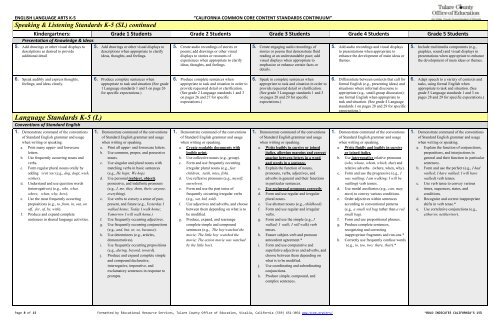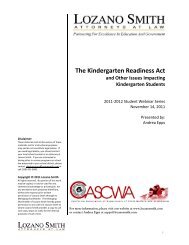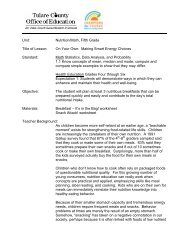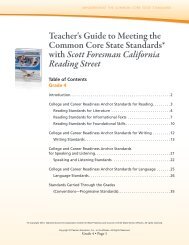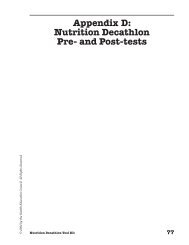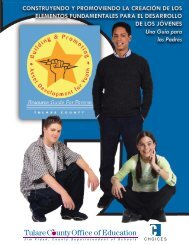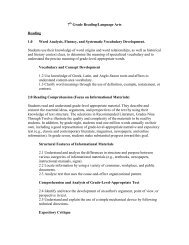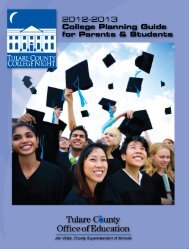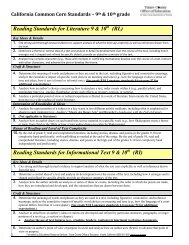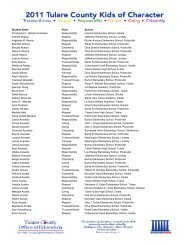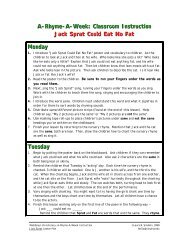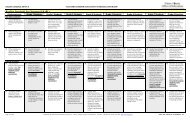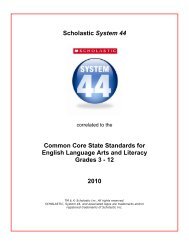ENGLISH LANGUAGE ARTS K‐5 “CALIFORNIA COMMON CORE CONTENT STANDARDS CONTINUUM”Speaking & Listening Standards K-5 (SL) continuedKindergartners: Grade 1 Students Grade 2 Students Grade 3 Students Grade 4 Students Grade 5 StudentsPresentation <strong>of</strong> Knowledge & Ideas5. Add drawings or other visual displays todescriptions as desired to provideadditional detail5. Add drawings or other visual displays todescriptions when appropriate to clarifyideas, thoughts, and feelings.5. Create audio recordings <strong>of</strong> stories orpoems; add drawings or other visualdisplays to stories or recounts <strong>of</strong>experiences when appropriate to clarifyideas, thoughts, and feelings.5. Create engaging audio recordings <strong>of</strong>stories or poems that demonstrate fluidreading at an understandable pace; addvisual displays when appropriate toemphasize or enhance certain facts ordetails.5. Add audio recordings and visual displaysto presentations when appropriate toenhance the development <strong>of</strong> main ideas orthemes.5. Include multimedia components (e.g.,graphics, sound) and visual displays inpresentations when appropriate to enhancethe development <strong>of</strong> main ideas or themes.6. Speak audibly and express thoughts,feelings, and ideas clearly.Language Standards K-5 (L)Conventions <strong>of</strong> Standard English6. Produce complete sentences whenappropriate to task and situation (See grade1 Language standards 1 and 3 on page 26for specific expectations.)6. Produce complete sentences whenappropriate to task and situation in order toprovide requested detail or clarification.(See grade 2 Language standards 1 and 3on pages 26 and 27 for specificexpectations.)6. Speak in complete sentences whenappropriate to task and situation in order toprovide requested detail or clarification.(See grade 3 Language standards 1 and 3on pages 28 and 29 for specificexpectations.)6. Differentiate between contexts that call forformal English (e.g., presenting ideas) andsituations where informal discourse isappropriate (e.g., small-group discussion);use formal English when appropriate totask and situation. (See grade 4 Languagestandards 1 on pages 28 and 29 for specificexpectations.)6. Adapt speech to a variety <strong>of</strong> contexts andtasks, using formal English whenappropriate to task and situation. (Seegrade 5 Language standards 1 and 3 onpages 28 and 29 for specific expectations.)1. Demonstrate command <strong>of</strong> the conventions<strong>of</strong> Standard English grammar and usagewhen writing or speaking.a. Print many upper- and lowercaseletters.b. Use frequently occurring nouns andverbs.c. Form regular plural nouns orally byadding /s/or /es/ (e.g., dog, dogs; wish,wishes).d. Understand and use question words(interrogatives) (e.g., who, what,where, when, why, how).e. Use the most frequently occurringprepositions (e.g., to, from, in, out, on<strong>of</strong>f, for, <strong>of</strong>, by, with).f. Produce and expand completesentences in shared language activities.1. Demonstrate command <strong>of</strong> the conventions<strong>of</strong> Standard English grammar and usagewhen writing or speaking.a. Print all upper- and lowercase letters.b. Use common, proper, and possessivenouns.c. Use singular and plural nouns withmatching verbs in basic sentences(e.g., He hops; We hop).d. Use personal (subject, object),possessive, and indefinite pronouns(e.g., I, me, they, them, their; anyone,everything).e. Use verbs to convey a sense <strong>of</strong> past,present, and future (e.g., Yesterday Iwalked home; Today I walk home;Tomorrow I will walk home.)f. Use frequently occurring adjectives.g. Use frequently occurring conjunctions(e.g., and, but, or, so, because).h. Use determiners (e.g., articles,demonstratives).i. Use frequently occurring prepositions(e.g., during, beyond, toward).j. Produce and expand complete simpleand compound declarative,interrogative, imperative, andexclamatory sentences in response toprompts.1. Demonstrate command <strong>of</strong> the conventions<strong>of</strong> Standard English grammar and usagewhen writing or speaking.a. Create readable documents withlegible print.b. Use collective nouns (e.g., group).c. Form and use frequently occurringirregular plural nouns (e.g., feetchildren, teeth, mice, fish).d. Use reflexive pronouns (e.g., myself,ourselves).e. Form and use the past tense <strong>of</strong>frequently occurring irregular verbs(e.g., sat, hid, told).f. Use adjectives and adverbs, and choosebetween them depending on what is tobe modified.g. Produce, expand, and rearrangecomplete simple and compoundsentences (e.g., The boy watched themovie; The little boy watched themovie; The action movie was watchedby the little boy).1. Demonstrate command <strong>of</strong> the conventions<strong>of</strong> Standard English grammar and usagewhen writing or speaking.a. Write legibly in cursive or joineditalics, allowing margins and correctspacing between letters in a wordand words in a sentence.b. Explain the function <strong>of</strong> nouns,pronouns, verbs, adjectives, andadverbs in general and their functionsin particular sentences.c. Use reciprocal pronouns correctlyd. Form and use regular and irregularplural nouns.e. Use abstract nouns (e.g., childhood)f. Form and use regular and irregularverbs.g. Form and use the simple (e.g., Iwalked; I walk; I will walk) verbtenses.h. Ensure subject-verb and pronounantecedent agreement.*i. Form and use comparative andsuperlative adjectives and adverbs, andchoose between them depending onwhat is to be modified.j. Use coordinating and subordinatingconjunctions.k. Produce simple, compound, andcomplex sentences.1. Demonstrate command <strong>of</strong> the conventions<strong>of</strong> Standard English grammar and usagewhen writing or speaking.a. Write fluidly and legibly in cursiveor joined italics.b. Use interrogative relative pronouns(who, whose, whom, which, that) andrelative adverbs (where, when, why).c. Form and use the progressive (e.g., Iwas walking; I am walking; I will bewalking) verb tenses.d. Use modal auxiliaries (e.g., can, may,must) to convey various conditions.e. Order adjectives within sentencesaccording to conventional patterns(e.g., a small red bag rather than a redsmall bag).f. Form and use prepositional phrases.g. Produce complete sentences,recognizing and correctinginappropriate fragments and run-ons.*h. Correctly use frequently confuse words(e.g., to, too, two; there, their).*1. Demonstrate command <strong>of</strong> the conventions<strong>of</strong> Standard English grammar and usagewhen writing or speaking.a. Explain the function <strong>of</strong> conjunctions,prepositions, and interjections ingeneral and their function in particularsentences.b. Form and use the perfect (e.g., I hadwalked; I have walked; I will havewalked) verb tenses.c. Use verb tense to convey varioustimes, sequences, states, andconditions.d. Recognize and correct inappropriateshifts in verb tense.*e. Use correlative conjunctions (e.g.,either/or, neither/nor).Page 8 <strong>of</strong> 15 Formatted by <strong>Education</strong>al Resource Services, <strong>Tulare</strong> <strong>County</strong> <strong>Office</strong> <strong>of</strong> <strong>Education</strong>, Visalia, California (559) 651‐3031 www.tcoe.org/ers/ *BOLD INDICATES CALIFORNIA’S 15%
ENGLISH LANGUAGE ARTS K‐5 “CALIFORNIA COMMON CORE CONTENT STANDARDS CONTINUUM”Language Standards K-5 (L)continuedKindergartners: Grade 1 Students Grade 2 Students Grade 3 Students Grade 4 Students Grade 5 StudentsConventions <strong>of</strong> Standard English2. Demonstrate command <strong>of</strong> the conventions<strong>of</strong> Standard English capitalization,punctuation, and spelling when writing.a. Capitalize the first word in a sentenceand the pronoun I.b. Recognize and name end punctuation.c. Write a letter or letters for mostconsonant and short-vowel sounds(phonemes).d. Spell simple words phonetically,drawing on knowledge <strong>of</strong> sound- letterrelationships.2. Demonstrate command <strong>of</strong> the conventions<strong>of</strong> Standard English capitalization,punctuation, and spelling when writing.a. Capitalize dates and names <strong>of</strong> people.b. Use end punctuation for sentences.c. Use commas in dates and to separatesingle words in a series.d. Use conventional spelling for wordswith common spelling patterns and forfrequently occurring irregular words.e. Spell untaught words phonetically,drawing on phonemic awareness andspelling conventions.2. Demonstrate command <strong>of</strong> the conventions<strong>of</strong> Standard English capitalization,punctuation, and spelling when writing.a. Capitalize holidays, product names,and geographic names.b. Use commas in greetings and closings<strong>of</strong> letters.c. Use an apostrophe to form contractionsand frequently occurring possessives.d. Generalize learned spelling patternswhen writing words (e.g., cage →badge; boy → boil).e. Consult reference materials, includingbeginning dictionaries, as needed tocheck and correct spellings.Knowledge <strong>of</strong> Language3. (Begins in grade 2) 3. (Begins in grade 2) 3. Use knowledge <strong>of</strong> language and itsconventions when writing, speaking,reading, or listening.a. Compare formal and informal uses <strong>of</strong>English.Vocabulary Acquisition and Use4. Determine or clarify the meaning <strong>of</strong>unknown and multiple-meaning words andphrases based on kindergarten readingand content.a. Identify new meanings for familiarwords and apply them accurately(e.g., knowing duck is a bird andlearning the verb to duck).b. Use the most frequently occurringinflections and affixes (e.g., -ed, -s, re-,un- pre-, -ful,-less) as a clue to themeaning <strong>of</strong> an unknown word.4. Determine or clarify the meaning <strong>of</strong>unknown and multiple-meaning words andphrases based on grade 1 reading andcontent, choosing flexibly from an array <strong>of</strong>strategies.a. Use sentence-level context as a clue tothe meaning <strong>of</strong> a word or phrase.b. Use frequently occurring affixes as aclue to the meaning <strong>of</strong> a word.c. Identify frequently occurring rootwords (e.g., look) and their inflectionalforms (e.g., looks, looked, looking).4. Determine or clarify the meaning <strong>of</strong>unknown and multiple-meaning words andphrases based on grade 2 reading andcontent, choosing flexibly from an array <strong>of</strong>strategies.a. Use sentence-level context as a clue tothe meaning <strong>of</strong> a word or phrase.b. Determine the meaning <strong>of</strong> the newword formed when a known prefix isadded to a known word (e.g.,happy/unhappy, tell/retell).c. Use a known root word as a clue to themeaning <strong>of</strong> an unknown word with thesame root (e.g., addition, additional).d. Use knowledge <strong>of</strong> the meaning <strong>of</strong>individual words to predict themeaning <strong>of</strong> compound words (e.g.,birdhouse, lighthouse, housefly;bookshelf, notebook, bookmark).e. Use glossaries and beginningdictionaries, both print and digital, todetermine or clarify the meaning <strong>of</strong>words and phrases in all content2. Demonstrate command <strong>of</strong> the conventions<strong>of</strong> Standard English capitalization,punctuation, and spelling when writing.a. Capitalize appropriate words in titles.b. Use commas in addresses.c. Use commas and quotation marks indialogue.d. Form and use possessives.e. Use conventional spelling for highfrequency and other studied words andfor adding suffixes to base words (e.g.,sitting, smiled, cries, happiness).f. Use spelling patterns andgeneralizations (e.g., word families,position-based spellings, syllablepatterns, ending rules, meaningfulword parts) in writing words.g. Consult reference materials, includingbeginning dictionaries, as needed tocheck and correct spellings.3. Use knowledge <strong>of</strong> language and itsconventions when writing, speaking,reading, or listening.a. Choose words and phrases for effect.*b. Recognize and observe differencesbetween the conventions <strong>of</strong> spoken andwritten standard English.4. Determine or clarify the meaning <strong>of</strong>unknown and multiple-meaning words andphrases based on grade 3 reading andcontent, choosing flexibly from a range <strong>of</strong>strategies.a. Use sentence-level context as a clue tothe meaning <strong>of</strong> a word or phrase.b. Determine the meaning <strong>of</strong> the newword formed when a known affix isadded to a known word (e.g.,agreeable /disagreeable, comfortable/uncomfortable, care/careless,heat/preheat).c. Use a known root word as a clue to themeaning <strong>of</strong> an unknown word with thesame root (e.g., company, companion).d. Use glossaries or beginningdictionaries, both print and digital, todetermine or clarify the precisemeaning <strong>of</strong> key words and phrases inall content areas.2. Demonstrate command <strong>of</strong> the conventions<strong>of</strong> Standard English capitalization,punctuation, and spelling when writing.a. Use correct capitalization.b. Use commas and quotation marks tomark direct speech and quotationsfrom a text.c. Use a comma before a coordinatingconjunction in a compound sentence.d. Spell grade-appropriate wordscorrectly, consulting references asneeded.3. Use knowledge <strong>of</strong> language and itsconventions when writing, speaking,reading, or listening.a. Choose words and phrases to conveyideas precisely.*b. Choose punctuation for effect.*c. Differentiate between contexts that callfor formal English (e.g., presentingideas) and situations where informaldiscourse is appropriate (e.g., smallgroup discussion).4. Determine or clarify the meaning <strong>of</strong>unknown and multiple-meaning words andphrases based on grade 4 reading andcontent, choosing flexibly from a range <strong>of</strong>strategies.a. Use context (e.g., definitions,examples, or restatements in text) as aclue to the meaning <strong>of</strong> a word orphrase.b. Use common, grade-appropriate Greekand Latin affixes and roots as clues tothe meaning <strong>of</strong> a word (e.g., telegraph,photograph, autograph).c. Consult reference materials (e.g.,dictionaries, glossaries, thesauruses),both print and digital, to find thepronunciation and determine or clarifythe precise meaning <strong>of</strong> key words andphrases and to identify alternateword choices in all content areas.2. Demonstrate command <strong>of</strong> the conventions<strong>of</strong> Standard English capitalization,punctuation, and spelling when writing.a. Use punctuation to separate items in aseries.*b. Use a comma to separate anintroductory element from the rest <strong>of</strong>the sentence.c. Use a comma to set <strong>of</strong>f the words yesand no (e.g., Yes, thank you), to set <strong>of</strong>fa tag question from the rest <strong>of</strong> thesentence (e.g., It’s true, isn’t it?), andto indicate direct address (e.g., Is thatyou, Steve?).d. Use underlining, quotation marks, oritalics to indicate titles <strong>of</strong> works.e. Spell grade-appropriate wordscorrectly, consulting references asneeded.3. Use knowledge <strong>of</strong> language and itsconventions when writing, speaking,reading, or listening.a. Expand, combine, and reducesentences for meaning, reader/listenerinterest, and style.b. Compare and contrast the varieties <strong>of</strong>English (e.g., dialects, registers) usedin stories, dramas, or poems.4. Determine or clarify the meaning <strong>of</strong>unknown and multiple-meaning words andphrases based on grade 5 reading andcontent, choosing flexibly from a range <strong>of</strong>strategies.a. Use context (e.g., cause/effectrelationships and comparisons in text)as a clue to the meaning <strong>of</strong> a word orphrase.b. Use common, grade-appropriate Greekand Latin affixes and roots as clues tothe meaning <strong>of</strong> a word (e.g.,photograph, photosynthesis).c. Consult reference materials (e.g.,dictionaries, glossaries, thesauruses),both print and digital, to find thepronunciation and determine or clarifythe precise meaning <strong>of</strong> key words andphrases and to identify alternateword choices in all content areas.Page 9 <strong>of</strong> 15 Formatted by <strong>Education</strong>al Resource Services, <strong>Tulare</strong> <strong>County</strong> <strong>Office</strong> <strong>of</strong> <strong>Education</strong>, Visalia, California (559) 651‐3031 www.tcoe.org/ers/ *BOLD INDICATES CALIFORNIA’S 15%


